| OCTOBER 2018 |
| Kabukiza (T˘ky˘) |  |
| Dates | 1 ~ 25 October 2018 Jűgatsu ďkabuki October Grand Kabuki |
| MatinÚe | |
| Evening | |
| Casting |
Living National Treasure Band˘ Tamasabur˘, Living National Treasure Kataoka Nizaemon, Matsumoto Haku˘, Nakamura Kankur˘, Nakamura Shichinosuke, Nakamura Senjaku, Band˘ Yajűr˘, Nakamura Kinnosuke, Nakamura Karoku, Nakamura Matagor˘, Kataoka Hidetar˘, Ichikawa Komaz˘, Nakamura Shid˘, Band˘ Minosuke, Matsumoto Haku˘, Ichimura Manjir˘, Band˘ Takesabur˘, Kataoka Kamez˘, Sawamura S˘nosuke, Matsumoto Kingo, Nakamura Kotar˘, Nakamura Kash˘, Ichimura Takematsu, ďtani Hirotar˘, Nakamura Tanenosuke, Nakamura Hayato, Kataoka Sennosuke, Nakamura Tamatar˘, Nakamura Tsurumatsu, Nakamura Kichinoj˘, Band˘ Kamez˘, Kataoka Matsunosuke, Arashi Kitsusabur˘ |
| Comments |
The Kabukiza commemorates the 6th anniversary (7th memorial services) of the passing away of the Heisei star Nakamura Kanzabur˘ XVIII.
|
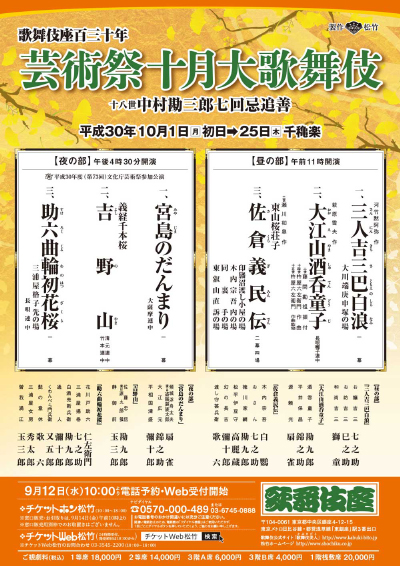 |
| National Theatre (T˘ky˘) |
| Dates | 1 ~ 25 October 2018 |
| Program |
|
| Casting |
Living National Treasure Nakamura T˘z˘, Nakamura Shikan, Kataoka Takatar˘, Nakamura Kikaku, Nakamura Matsue, Nakamura Hashinosuke, Nakamura Fukunosuke, Nakamura Baika, Band˘ Shingo |
| Comments |
Chikamatsu Monzaemon's drama "Heike Nyogo no Shima" is staged as a t˘shi ky˘gen at the National Theatre. The "Shikina no Ura" act was staged for the last time in October 1995 (only revival since the end of WWII). The other rarely-staged act, "Rokuhara Kiyomori Yakata", was staged three times, always at the National Theatre: April 1967, October 1995 and October 2007.
|
| Misonoza (Nagoya) |  |
| Dates | 1 ~ 25 October 2018 Kichirei Kaomise Annual Festive Face-Showing Program |
| MatinÚe |
Yoshitsune Senbon Zakura Nozarashi Gosuke |
| Evening |
Yowa Nasake Ukina no Yokogushi (Kirare Yosa)
|
| Casting |
Living National Treasure Onoe Kikugor˘, Nakamura Tokiz˘, Nakamura Baigyoku, Nakamura Kaishun, Onoe Sh˘roku, Ichikawa Sadanji, Ichikawa Danz˘, Band˘ Rakuzen, Band˘ Hikosabur˘, Band˘ Kamez˘, Band˘ Shűch˘, Kawarasaki Gonjűr˘, Nakamura Baishi, Ichimura Kitsutar˘, Nakamura Mantar˘, Onoe Ukon |
| Comments |
The classic October kaomise programs in Nagoya. For the first time at the Misonoza since its reopening in April 2018. This is the 49th kaomise in Nagoya.
|
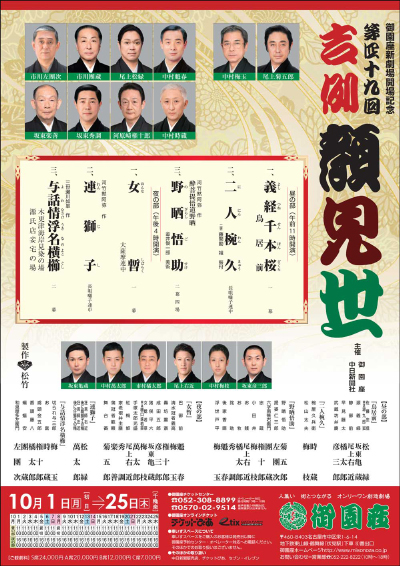 |
| Sh˘chikuza (ďsaka) |  |
| Dates | 2 ~ 26 October 2018 Jűgatsu ďkabuki October Grand Kabuki |
| MatinÚe |
Kami no Megumi Wag˘ no Torikumi Tamaya Seikichi |
| Evening | |
| Casting |
Living National Treasure Sakata T˘jűr˘, Ichikawa Ebiz˘, Ichikawa Ennosuke, Nakamura Jakuemon, Nakamura Ganjir˘, Ichikawa Udanji, Ichikawa Sai'nyű, Ichikawa Ukon, ďtani Tomoemon, Kataoka Ichiz˘, Ichimura Kakitsu, Ichikawa Monnosuke, Ichikawa Emisabur˘, Ichikawa Emiya, Ichikawa Omez˘, Ichikawa Kudanji, Nakamura Jűjir˘, Nakamura Yonekichi, ďtani Hiromatsu, Ichikawa Otora, Ichikawa K˘tar˘ |
| Comments |
Ichikawa Udanji III and Ichikawa Sai'nyű II celebrate their shűmei in ďsaka at the Sh˘chikuza.
|
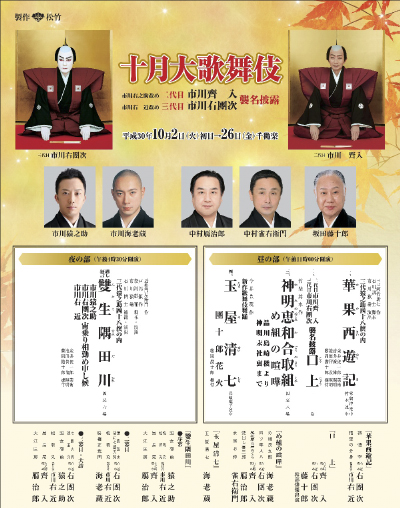 |
| Eirakukan (Toyooka) |  |
| Dates | 18 ~ 24 October 2018 Eirakukan ďkabuki Eirakukan Grand Kabuki |
| Program |
Gosho Zakura Horikawa no Youchi (Benkei J˘shi) K˘ no Tori |
| Casting |
Kataoka Ainosuke, Nakamura Kazutar˘, Kamimura Kichiya, ďtani Keiz˘ |
| Comments |
This is the 11th Kabuki program at the Eirakukan, a renovated traditional theater built in the city of Toyooka (prefecture of Hy˘go). |
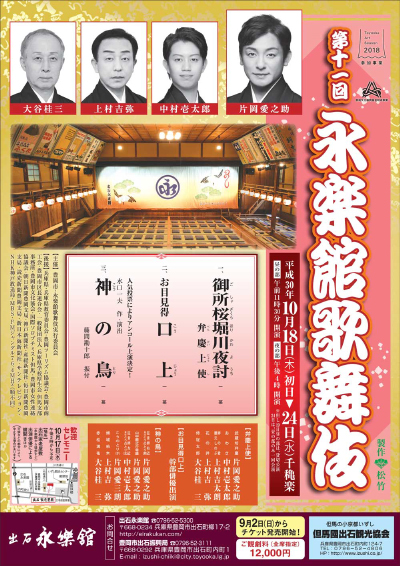 |
|
|||
| Dates | 30 October ~ 04 November 2018 Band˘ Tamasabur˘ Eiz˘ x Buy˘ K˘en Band˘ Tamasabur˘ Image and Dance Performances |
||
| Program | |||
| Casting |
Living National Treasure Band˘ Tamasabur˘ |
||
| Comments |
A special Buy˘ program starring the amazing Living National Treasure onnagata Band˘ Tamasabur˘ in Yamaga at the Yachiyoza, a traditional wooden-built theater. There is a mix of video projection (with video sequences coming from the high-quality Shinema Kabuki, "Cinema Kabuki") and real dancing on stage.
|
||
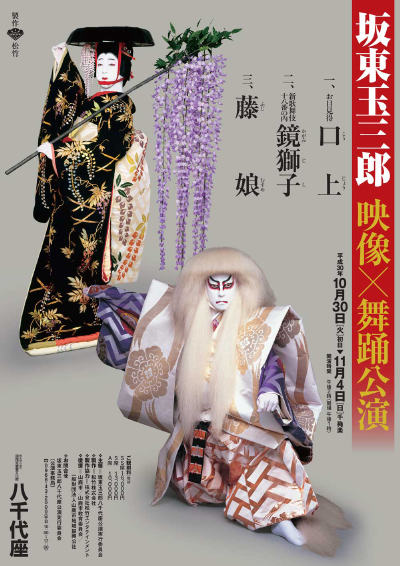 |
| National Bunraku Theatre (ďsaka) |
| Dates | 4 ~ 10 October 2018 Zenshinza Tokubetsu K˘en Zenshinza Special Performances |
| Program |
Ura Nagaya S˘d˘ki |
| Casting |
Kawarasaki Kunitar˘, Arashi Yoshisabur˘, Fujikawa Yanosuke, Matsunami Kihachir˘, Tadamura Shin'ya |
| Comments |
Special Zenshinza performances in ďsaka. Not at the Minamiza, as it used to be, but at the Ky˘to Gekij˘. "Ura Nagaya S˘d˘ki", which was written by the veteran movie director Yamada Y˘ji and was premiered in May 2017 at the National Theatre, is based on two famous rakugo stories, "Rakuda" and "Ido no Chawan". |
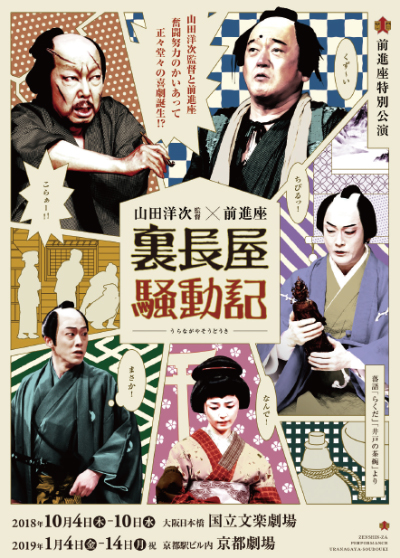 |
| Daisen Park (Sakai) | |
| Dates | 13 October 2018 Kataoka Ainosuke Tokubetsu K˘en Kataoka Ainosuke Special Performance |
| Program |
T˘ku Nasu Monogatari |
| Casting | |
| Comments |
A special Kabuki performance on a temporary stage built at the Daisen Park in the city of Sakai. This is the 37th edition of the World Heritage Theater, theater performances in world heritage sites in Japan. Mozu Kofungun, the Mozu Tombs in Sakai. The first item in this program is a talk about the event. The second item is a Ky˘gen dance-drama performed by the ky˘genshi Shigeyama Ippei. The third and last item is the famous Kabuki dance "Yoshinoyama". |
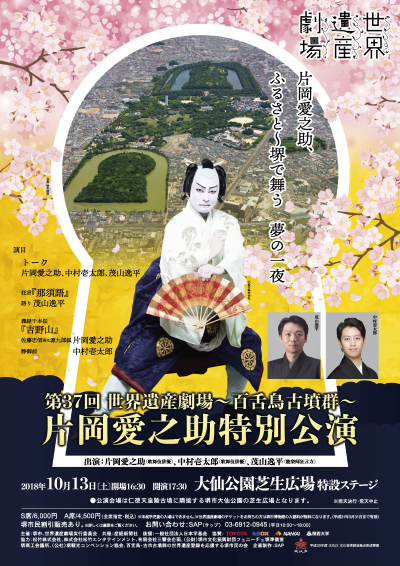 |
| Shibuya-ku Bunka S˘g˘ Center ďwada (T˘ky˘) |  |
| Dates | 22 October 2018 |
| Program |
Shibuya Konn˘maru Densetsu |
| Casting | |
| Comments |
A newly-created Kabuki dance at the Shibuya-ku Bunka S˘g˘ Center ďwada. Ichikawa Somegor˘ shares the stage with the dance masters Onoe Miyako and Goj˘ Tamatar˘. |
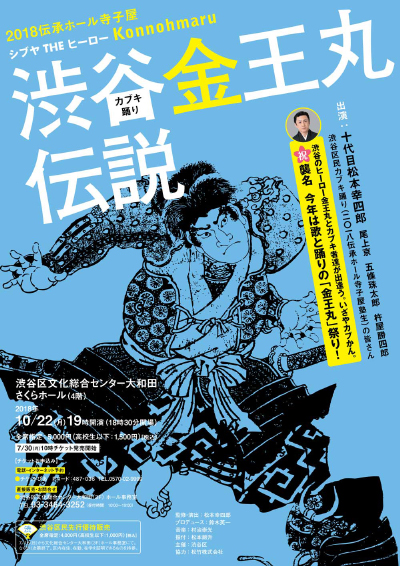 |
|
|
| Contact | Main | Top | Updates | Actors | Plays | Playwrights | Programs | Links | FAQ | Glossary | Chronology | Illustrations | Prints | Characters | Derivatives | Theaters | Coming soon | News |